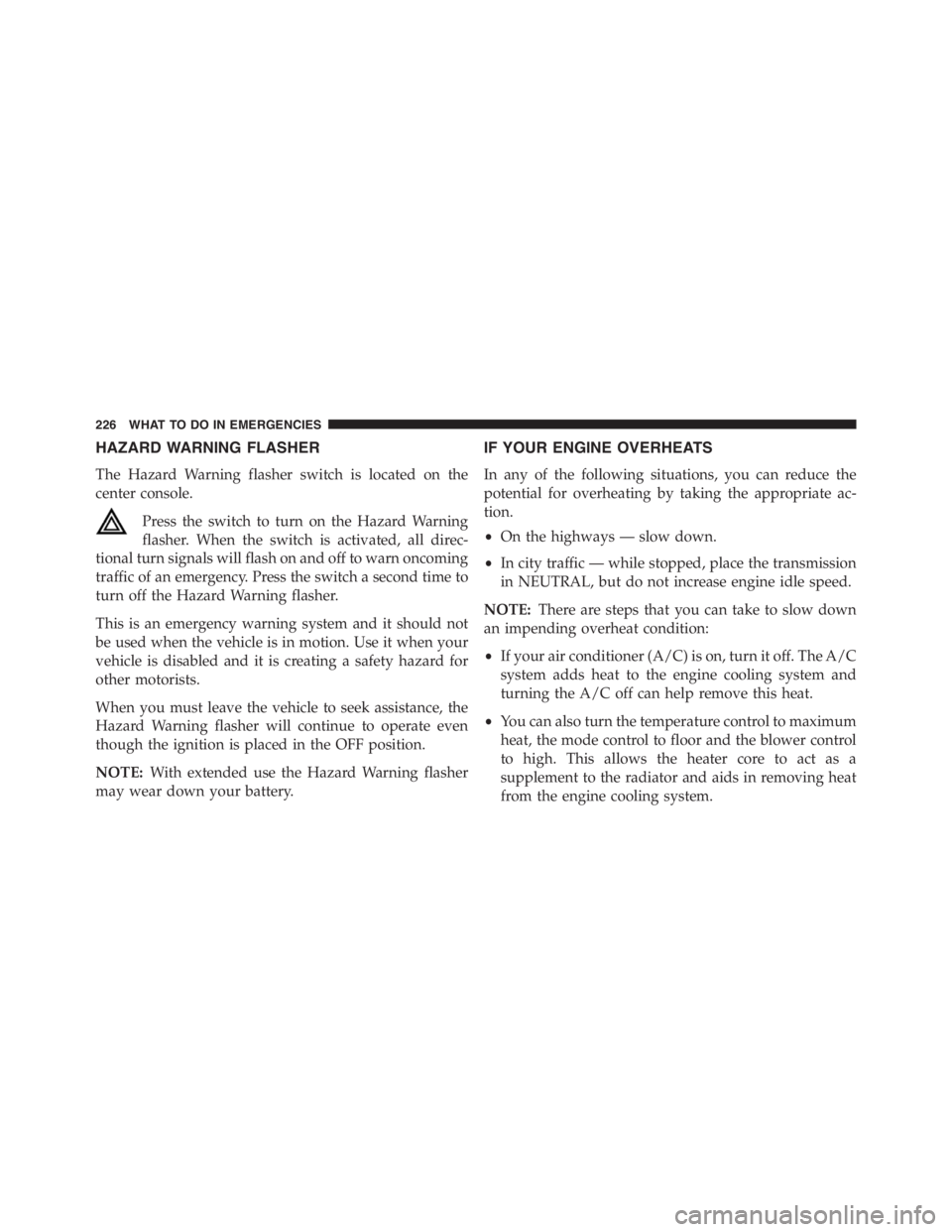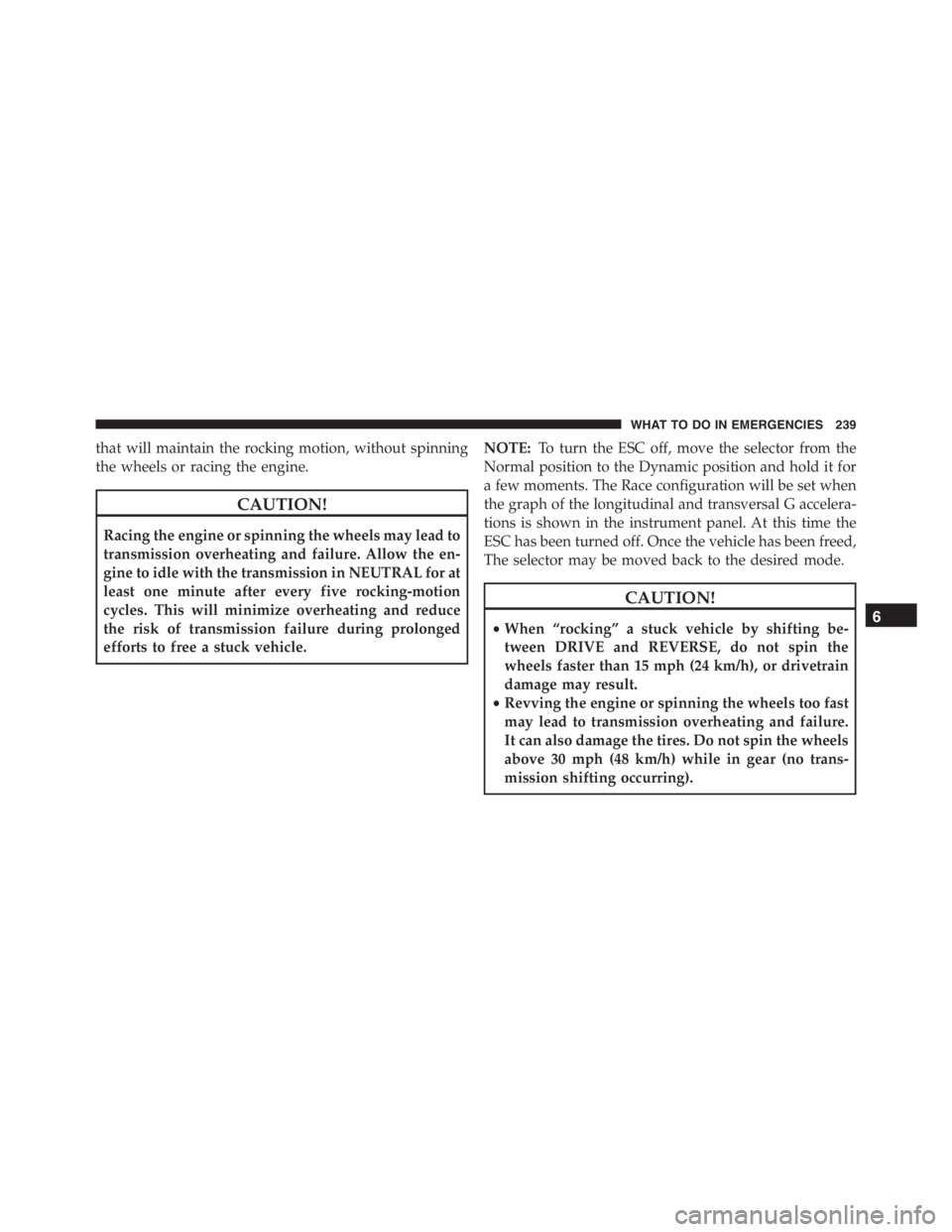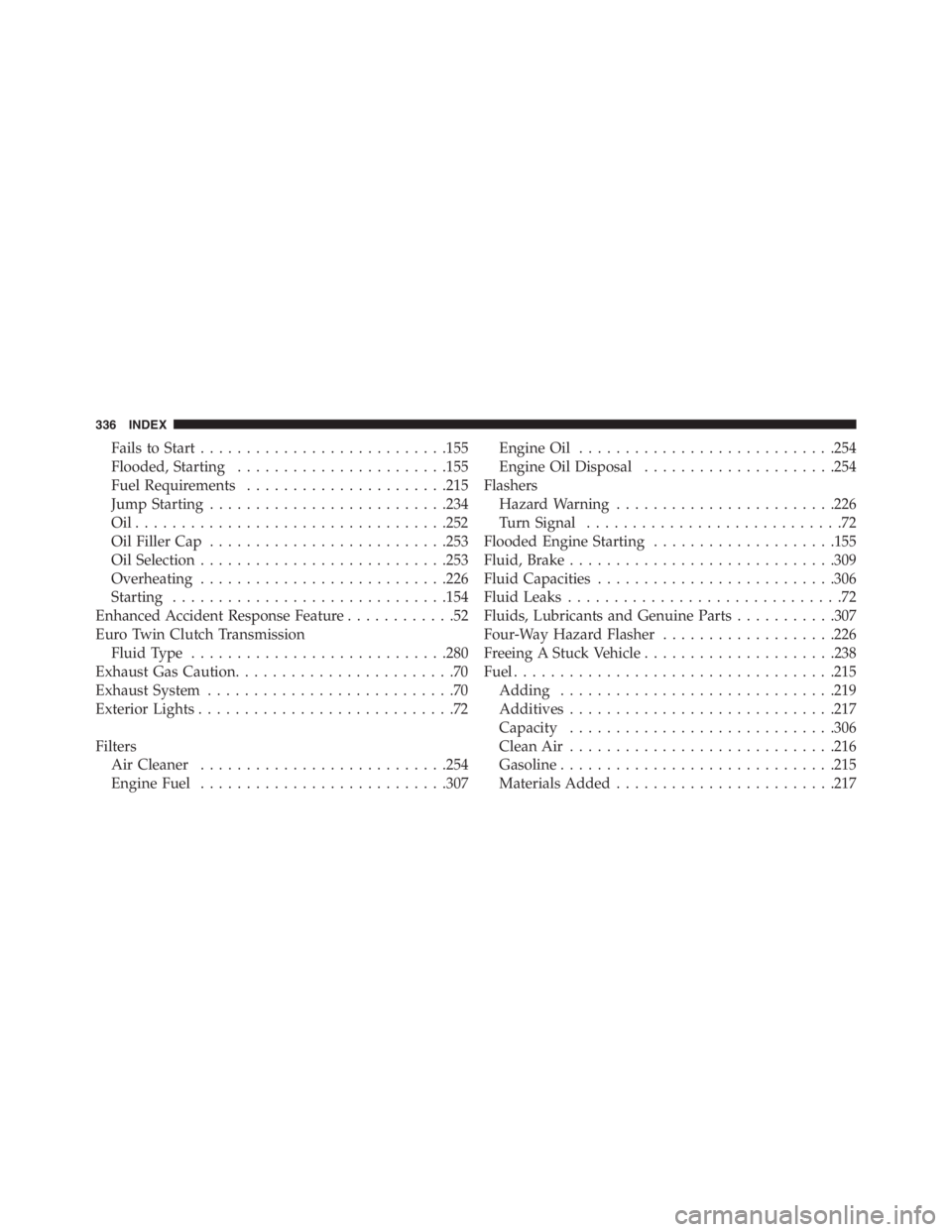2015 PEUGEOT 4C overheating
[x] Cancel search: overheatingPage 198 of 348

WARNING!
Overloading of your tires is dangerous. Overloading
can cause tire failure, affect vehicle handling, and
increase your stopping distance. Use tires of the
recommended load capacity for your vehicle. Never
overload them.
TIRES — GENERAL INFORMATION
Tire Pressure
Proper tire inflation pressure is essential to the safe and
satisfactory operation of your vehicle. Four primary areas
are affected by improper tire pressure:
•Safety and Vehicle Stability
•Economy
•Tread Wear
•Ride Comfort
Safety
WARNING!
•Improperly inflated tires are dangerous and can
cause collisions.
•Under-inflation increases tire flexing and can re-
sult in overheating and tire failure.
•Over-inflation reduces a tire’s ability to cushion
shock. Objects on the road and chuckholes can
cause damage that result in tire failure.
•Overinflated or under-inflated tires can affect ve-
hicle handling and can fail suddenly, resulting in
loss of vehicle control.
•Unequal tire pressures can cause steering prob-
lems. You could lose control of your vehicle.
(Continued)
196 STARTING AND OPERATING
Page 228 of 348

HAZARD WARNING FLASHER
The Hazard Warning flasher switch is located on the
center console.
Press the switch to turn on the Hazard Warning
flasher. When the switch is activated, all direc-
tional turn signals will flash on and off to warn oncoming
traffic of an emergency. Press the switch a second time to
turn off the Hazard Warning flasher.
This is an emergency warning system and it should not
be used when the vehicle is in motion. Use it when your
vehicle is disabled and it is creating a safety hazard for
other motorists.
When you must leave the vehicle to seek assistance, the
Hazard Warning flasher will continue to operate even
though the ignition is placed in the OFF position.
NOTE:With extended use the Hazard Warning flasher
may wear down your battery.
IF YOUR ENGINE OVERHEATS
In any of the following situations, you can reduce the
potential for overheating by taking the appropriate ac-
tion.
•On the highways — slow down.
•In city traffic — while stopped, place the transmission
in NEUTRAL, but do not increase engine idle speed.
NOTE:There are steps that you can take to slow down
an impending overheat condition:
•If your air conditioner (A/C) is on, turn it off. The A/C
system adds heat to the engine cooling system and
turning the A/C off can help remove this heat.
•You can also turn the temperature control to maximum
heat, the mode control to floor and the blower control
to high. This allows the heater core to act as a
supplement to the radiator and aids in removing heat
from the engine cooling system.
226 WHAT TO DO IN EMERGENCIES
Page 241 of 348

that will maintain the rocking motion, without spinning
the wheels or racing the engine.
CAUTION!
Racing the engine or spinning the wheels may lead to
transmission overheating and failure. Allow the en-
gine to idle with the transmission in NEUTRAL for at
least one minute after every five rocking-motion
cycles. This will minimize overheating and reduce
the risk of transmission failure during prolonged
efforts to free a stuck vehicle.NOTE:To turn the ESC off, move the selector from the
Normal position to the Dynamic position and hold it for
a few moments. The Race configuration will be set when
the graph of the longitudinal and transversal G accelera-
tions is shown in the instrument panel. At this time the
ESC has been turned off. Once the vehicle has been freed,
The selector may be moved back to the desired mode.
CAUTION!
•When “rocking” a stuck vehicle by shifting be-
tween DRIVE and REVERSE, do not spin the
wheels faster than 15 mph (24 km/h), or drivetrain
damage may result.
•Revving the engine or spinning the wheels too fast
may lead to transmission overheating and failure.
It can also damage the tires. Do not spin the wheels
above 30 mph (48 km/h) while in gear (no trans-
mission shifting occurring).6
WHAT TO DO IN EMERGENCIES 239
Page 269 of 348

Under normal operating conditions, the catalytic con-
verter will not require maintenance. However, it is im-
portant to keep the engine properly tuned to assure
proper catalyst operation and prevent possible catalyst
damage.
NOTE:Intentional tampering with emissions control
systems can result in civil penalties being assessed
against you.
In unusual situations involving grossly malfunctioning
engine operation, a scorching odor may suggest severe
and abnormal catalyst overheating. If this occurs, stop
the vehicle, turn off the engine and allow it to cool.
Service, including a tune-up to manufacturer’s specifica-
tions, should be obtained immediately.To minimize the possibility of catalytic converter dam-
age:
•Do not shut off the engine or interrupt the ignition,
when the transmission is in gear and the vehicle is in
motion.
•Do not try to start the engine by pushing or towing the
vehicle.
•Do not idle the engine with any spark plug wires
disconnected or removed, such as when diagnostic
testing, or for prolonged periods during very rough
idle or malfunctioning operating conditions.
7
MAINTAINING YOUR VEHICLE 267
Page 337 of 348

Change Engine Oil......................137
Change Engine Oil Indicator System..........137
Daytime Running Lamps (DRL).............136
Distance Traveled.......................141
Electronic Vehicle Information Center (EVIC). . . .125
Electronic Vehicle Information Center (EVIC) Setup
Menu................................127
Exit Menu............................137
Exit Trip..............................139
Fuel Range............................140
Indications On Display...................140
Instant Fuel Consumption.................141
Language (Selecting The Language)..........134
NewTrip .............................139
Oil Life..............................137
Service (Scheduled Servicing)...............135
Set Date..............................131
Speed Beep (Speed Limit).................128
Start Of Trip Procedure...................139Time Adjustment (Clock)..................130
Travel Time...........................141
Trip Button............................137
Trip Computer.........................137
Trip Functions.........................138
Units (Set Units)........................133
Values Displayed.......................140
Emergency, In Case of
Freeing Vehicle When Stuck................238
Hazard Warning Flasher..................226
Jump Starting..........................234
Overheating...........................226
Engine
Air Cleaner...........................254
Break-In Recommendations.................68
Checking Oil Level......................252
Compartment..........................249
Cooling..............................268
Exhaust Gas Caution.....................70
10
INDEX 335
Page 338 of 348

Fails to Start...........................155
Flooded, Starting.......................155
Fuel Requirements......................215
Jump Starting..........................234
Oil..................................252
Oil Filler Cap..........................253
Oil Selection...........................253
Overheating...........................226
Starting..............................154
Enhanced Accident Response Feature............52
Euro Twin Clutch Transmission
Fluid Type............................280
Exhaust Gas Caution........................70
Exhaust System...........................70
Exterior Lights............................72
Filters
Air Cleaner...........................254
Engine Fuel...........................307Engine Oil............................254
Engine Oil Disposal.....................254
Flashers
Hazard Warning........................226
Turn Signal............................72
Flooded Engine Starting....................155
Fluid, Brake.............................309
Fluid Capacities..........................306
Fluid Leaks..............................72
Fluids, Lubricants and Genuine Parts...........307
Four-Way Hazard Flasher...................226
Freeing A Stuck Vehicle.....................238
Fuel...................................215
Adding..............................219
Additives.............................217
Capacity.............................306
Clean Air.............................216
Gasoline..............................215
Materials Added........................217
336 INDEX
Page 342 of 348

Onboard Diagnostic System..................250
Operating Precautions......................250
Operator Manual (Owner’s Manual).............5
Outside Rearview Mirrors....................76
Overheating, Engine.......................226
Owner’s Manual (Operator Manual).............5
Paint Care..............................280
Parking Brake............................173
Passing Light.............................87
Pets....................................68
Pets, Transporting..........................68
Placard, Tire and Loading Information..........192
Power
Door Locks............................23
Mirrors...............................77
Windows..............................27
Pregnant Women and Seat Belts................40
PretensionersSeat Belts..............................41
Radial Ply Tires..........................199
Radio Operation..........................142
Reclining Front Seats.......................80
Recreational Towing.......................222
Reformulated Gasoline.....................216
Refrigerant..............................258
Reminder, Seat Belt.........................34
Remote Keyless Entry (RKE)
FCC General Information..................23
Remote Keyless Entry (RKE)................19
Unlock The Doors.......................20
Replacement Bulbs........................292
Replacement Keys.........................14
Replacement Parts.........................250
Replacement Tires.........................206
Reporting Safety Defects....................325
Restraint, Head...........................81
340 INDEX